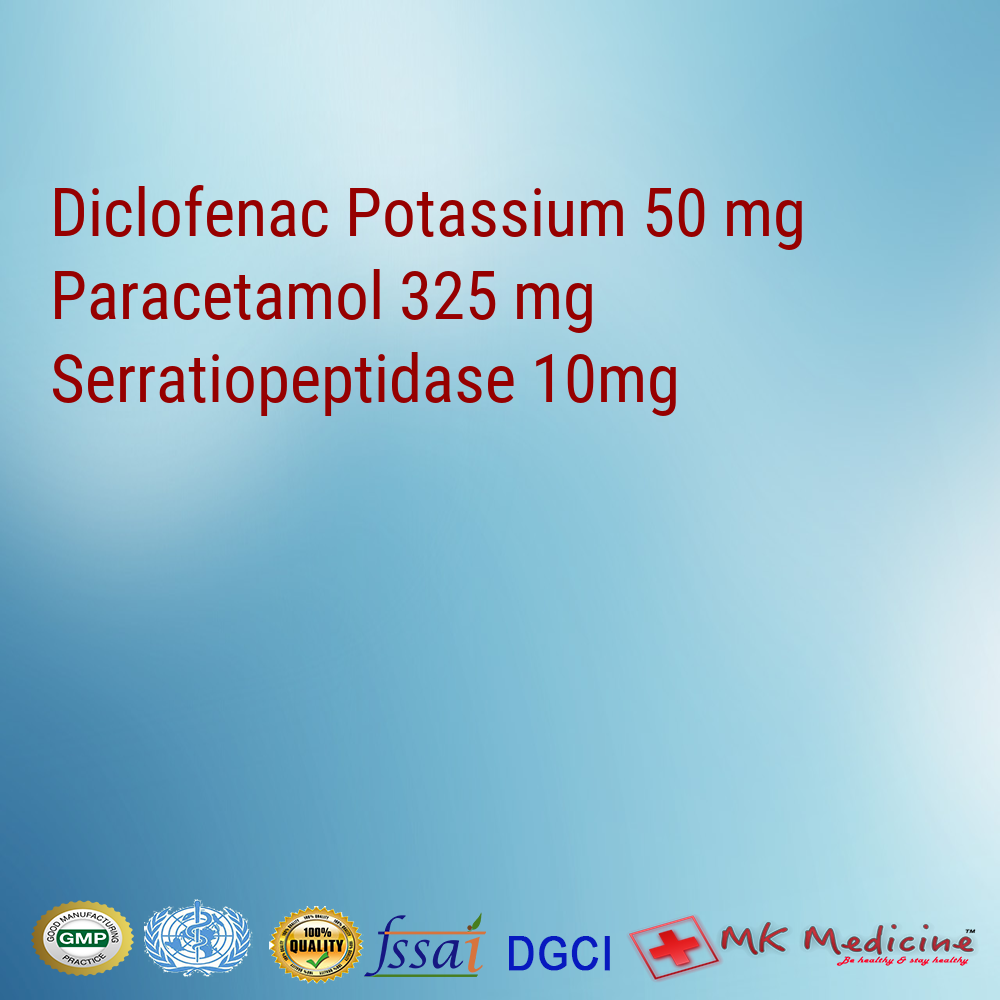Diclofenac Potassium is a nonsteroidal anti-inflammatory drug (NSAIDs) that exhibits anti- inflammatory, analgesic, and antipyretic activities.
Paracetamol, also known as Acetaminophen, is commonly used for its analgesic and antipyretic effects. Serratiopeptidase is a proteolytic enzyme (protease) produced by Enterobacterium Serratia sp. E-15 used in the prevention of pain and swelling.
Diclofenac Potassium:
● For treatment of primary dysmenorrhea.
● For relief of mild to moderate pain.
● For relief of the signs and symptoms of osteoarthritis.
● For relief of the signs and symptoms of rheumatoid arthritis.
Paracetamol:
● For mild to moderate pain (from headaches, menstrual periods, toothaches, backaches, osteoarthritis, or cold/flu aches and pains).
● To reduce fever.
Serratiopeptidase:
● Anti-inflammatory properties.
● Post-traumatic swelling.
● Fibrocystic breast disease.
● Bronchitis.
MK Medicine is a leading pcd franchise provider, contract manufacturer and hospital supplier of WHO-GMP certified Diclofenac Potassium 50 mg Paracetamol 325 mg Serratiopeptidase 10mg
Paracetamol causes increased risk of liver damage in chronic alcoholics along with an increased risk of toxicity with high doses or long term administration of barbiturates, carbamazepine, hydantoins, isoniazid, rifampin and sulfinpyrazone. Diclofenac potassium , should be taken with food. Take the drug immediately after meals to avoid GI disturbances.
● Skin rash
● Diarrhea
● Gastrointestinal disturbance/Abdominal pain (or stomach pain)/Heartburn or
● Nose bleed
● Nausea
● Allergic reactions
● Dizziness
Diclofenac Potassium:
Diclofenac is an acetic acid non-steroidal anti-inflammatory drug (NSAID) with analgesic and antipyretic properties. Diclofenac inhibits the production of prostaglandins by inhibiting COX-1 and COX-2 pathways thereby exhibiting anti- inflammatory effects.
Absorption: Well absorbed following oral administration.
Distribution: widely distributed in animals. Plasma protein binding exhibited is >99%.
Elimination: Hepatic metabolism leads to elimination through urine.
Serratiopeptidase:
Serratiopeptidase is an enzyme isolated from a non-pathogenic bacteria called Enterobacteria Serratia E15. Serratiopeptidase has powerful anti-inflammatory properties and is particularly useful for post-traumatic swelling, fibrocystic breast disease and bronchitis. It is able to digest dead tissue, blood clots, cysts, and arterial plaques.
Absorption: On oral administration, serratiopeptidase is absorbed in GI tract.
Distribution: Distributed throughout the body tissues, unchanged via systemic circulation. It reaches in higher concentration in inflamed tissues. Serratiopeptidase levels in inflammatory exudates rises gradually with decline in blood levels indicating that serratiopeptidase is quite rapidly transferred to the site of inflammation.
Paracetamol:
Paracetamol is a widely used analgesic and antipyretic agent.
Absorption: Paracetamol is well absorbed in gastro intestinal tract. Oral bioavailability is dose dependant since the half life of Paracetamol is 1-3hrs.Distribution:Paracetamol is distributed throughout the body fluids in a homogeneous way. Paracetamol given at therapeutic doses binds to plasma proteins at less than 20%.
Elimination: Metabolites are excreted through the kidneys in the urine.
Important Notice:- The Database is still under development and may contain inaccuracies. It is not intended as a substitute for the expertise and judgement of your physician, pharmacist or other healthcare professional. It should not be construed to indicate that the use of any medication in any country is safe, appropriate or effective for you. Consult with your healthcare professional before taking any medication.


Aceclofenac 200 mg Sustained Release Tablet